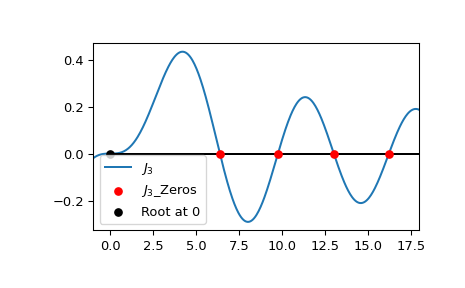scipy.special.
jn_zeros#
- scipy.special.jn_zeros(n, nt)[源代码]#
计算整数阶贝塞尔函数 Jn 的零点。
计算贝塞尔函数 \(J_n(x)\) 在区间 \((0, \infty)\) 上的 nt 个零点。零点按升序返回。请注意,此区间不包括当 \(n > 0\) 时存在的 \(x = 0\) 处的零点。
- 参数:
- n整型
贝塞尔函数的阶数
- nt整型
要返回的零点数量
- 返回:
- ndarray
贝塞尔函数的前 nt 个零点。
参考文献
[1]Zhang, Shanjie and Jin, Jianming. “Computation of Special Functions”, John Wiley and Sons, 1996, chapter 5. https://people.sc.fsu.edu/~jburkardt/f77_src/special_functions/special_functions.html
示例
计算 \(J_3\) 的前四个正零点。
>>> from scipy.special import jn_zeros >>> jn_zeros(3, 4) array([ 6.3801619 , 9.76102313, 13.01520072, 16.22346616])
绘制 \(J_3\) 及其前四个正零点。请注意,
jn_zeros不会返回位于 0 处的零点。>>> import numpy as np >>> import matplotlib.pyplot as plt >>> from scipy.special import jn, jn_zeros >>> j3_roots = jn_zeros(3, 4) >>> xmax = 18 >>> xmin = -1 >>> x = np.linspace(xmin, xmax, 500) >>> fig, ax = plt.subplots() >>> ax.plot(x, jn(3, x), label=r'$J_3$') >>> ax.scatter(j3_roots, np.zeros((4, )), s=30, c='r', ... label=r"$J_3$_Zeros", zorder=5) >>> ax.scatter(0, 0, s=30, c='k', ... label=r"Root at 0", zorder=5) >>> ax.hlines(0, 0, xmax, color='k') >>> ax.set_xlim(xmin, xmax) >>> plt.legend() >>> plt.show()
